A Modified Formulation of Singular Boundary Method for Exterior Acoustics
Yi Wu,Zhuojia Fuand Jian Min
Institute of Grid and High Performance Computing,College of Mechanics and Materials,Hohai University,Nanjing,211100,China
ABSTRACT This paper proposes a modified formulation of the singular boundary method(SBM)by introducing the combined Helmholtz integral equation formulation (CHIEF) and the self-regularization technique to exterior acoustics.In the SBM, the concept of the origin intensity factor (OIF) is introduced to avoid the singularities of the fundamental solutions.The SBM belongs to the meshless boundary collocation methods.The additional use of the CHIEF scheme and the self-regularization technique in the SBM guarantees the unique solution of the exterior acoustics accurately and efficiently.Consequently, by using the SBM coupled with the CHIEF scheme and the self-regularization technique, the accuracy of the numerical solution can be improved, especially near the corresponding internal characteristic frequencies.Several numerical examples of two-dimensional and threedimensional benchmark examples about exterior acoustics are used to verify the effectiveness and accuracy of the proposed method.The proposed numerical results are compared with the analytical solutions and the solutions obtained by the other numerical methods.
KEYWORDS Singular boundary method;CHIEF method;self-regularization technique;acoustic radiation and scattering
1 Introduction
As we all know, the main numerical methods to study acoustic radiation and scattering are the finite element method (FEM) [1–4] and the boundary element method (BEM) [5–7].The FEM is a general method for solving mathematical and physical equations.However, the FEM is difficult in dealing with the infinite domain problems and needs several additional technologies[8–10].The BEM is a boundary-type numerical algorithm after the FEM.The fundamental solutions of the BEM can automatically satisfy the Sommerfeld radiation condition at infinity,so the BEM can effectively deal with infinite domain problems.Moreover, the BEM only needs the boundary discretization on the surface of the considered computational domains, so that it can save the computational resources.Therefore,the BEM is a competitive option for infinite domain problems.However,the fundamental solution of the BEM has singularities,which leads to a great deal of difficulty in the calculation of the singular/hypersingular integrals.This is also the main factor limiting the application of BEM.
To avoid these troublesome calculations in the BEM,the method of fundamental solutions(MFS)[11–16] was proposed.It distributes the source points outside the solution domain to overcome the singularities of the fundamental solutions, which is effective and easy to implement.However, the optimal placement of the source points is a nontrivial task, which has a big effect on the numerical stability and accuracy in the MFS, in particular the problems with multi-connected domains or complicated-geometric-shaped domains.
Then the boundary knot method (BKM) [17–19] has been proposed, which employs the nonsingular general solutions as basis functions instead of the singular fundamental solutions.It avoids the troublesome placement of the source points in the MFS.However,it cannot be used for exterior Helmholtz problems due to the nontrivial task of the derivation of the nonsingular general solutions.To overcome this drawback,several numerical methods have been proposed to solve acoustic radiation and scattering problems in recent years, such as the singular boundary method (SBM) [20–24], the regularized meshless method (RMM) [25,26], and so on.Here we focus on the singular boundary method(SBM).
The SBM introduces the concept of origin intensity factor (OIF) [27] to substitute the singular term in the interpolation expression,so that we can obtain the non-singular interpolation expression.In order to determine the OIF, the SBM uses the inverse interpolation technique (IIT) [28], which needs to construct the sample solution and select the sample nodes in the physical domain.However,the accuracy of numerical results will be affected sensitively by the selection of sample points,which limits the application of the method in three-dimensional problems.The improved formulation of the singular boundary method is proposed by Chen and his coworkers[29–32]to overcome this issue.The method derives the origin intensity factor through the subtracting and adding-back technique,so as to avoid the selection of sample nodes in the SBM.
Although the improved formulation of the SBM has been applied to the acoustic wave propagation problems [33–35], it still cannot obtain the correct numerical results in the solution of the acoustic radiation and scattering problems in the infinite domain,which is caused by the non-uniqueness issue appeared near the corresponding internal characteristic frequencies.The combined Helmholtz integral equation formulation (CHIEF) method [36–38] and the Burton-Miller formulation [7,21] are two popular schemes to avoid this non-uniqueness issue.However,the CHIEF method can only avoid the uniqueness issue at some but not all characteristic frequencies.And the Burton-Miller formulation is usually difficult to calculate due to the existence of singularities and hyper-singularities in fundamental solutions.Inspire by Chen’s work[39]in indirect BEM,this study constructs a modified formulation of the SBM based on CHIEF method and self-regularization technique to deal with this non-uniqueness issue.
This paper presents a modified formulation of the SBM in conjunction with the CHIEF method and self-regularization technique to exterior acoustics analysis.The paper is briefly summarized as follows:Section 2 introduces the modified formulation of the SBM in conjunction with the CHIEF method and self-regularization technique.Section 3 verifies the accuracy of the proposed method and compared the present solutions with the analytical solutions and the solutions of other methods through several typical benchmark examples.Finally,Section 4 presents some conclusions of the study.
2 Methodology
Considering the propagation of time-harmonic acoustic waves in a homogeneous isotropic, the acoustic radiation and scattering can be described by the Helmholtz equation

and the boundary conditions

whereDis the exterior domain,stands for the wave number, in whichcdenotes the sound velocity,ωpresents the angular frequency.Respectively,ΓDandΓNrepresent the Dirichlet boundary and Neumann boundary.For different types of the acoustics problems,the acoustic pressureu(x)can be expressed as

where the subscriptsT,R,S,increpresent the total, radiation, scattering and incidence wave,respectively.For the physical and mechanical problems, it is required to impose the well-known Sommerfeld radiation condition on the infinite boundary conditions

wherenstands for the dimension of the problem andi=
2.1 Original Singular Boundary Method(SBM)
Considering the Helmholtz equation with infinite domain,the single-layer fundamental solution is used as the interpolation basic function in the SBM.The approximate solutionsu(x)andq(x)can be expressed as


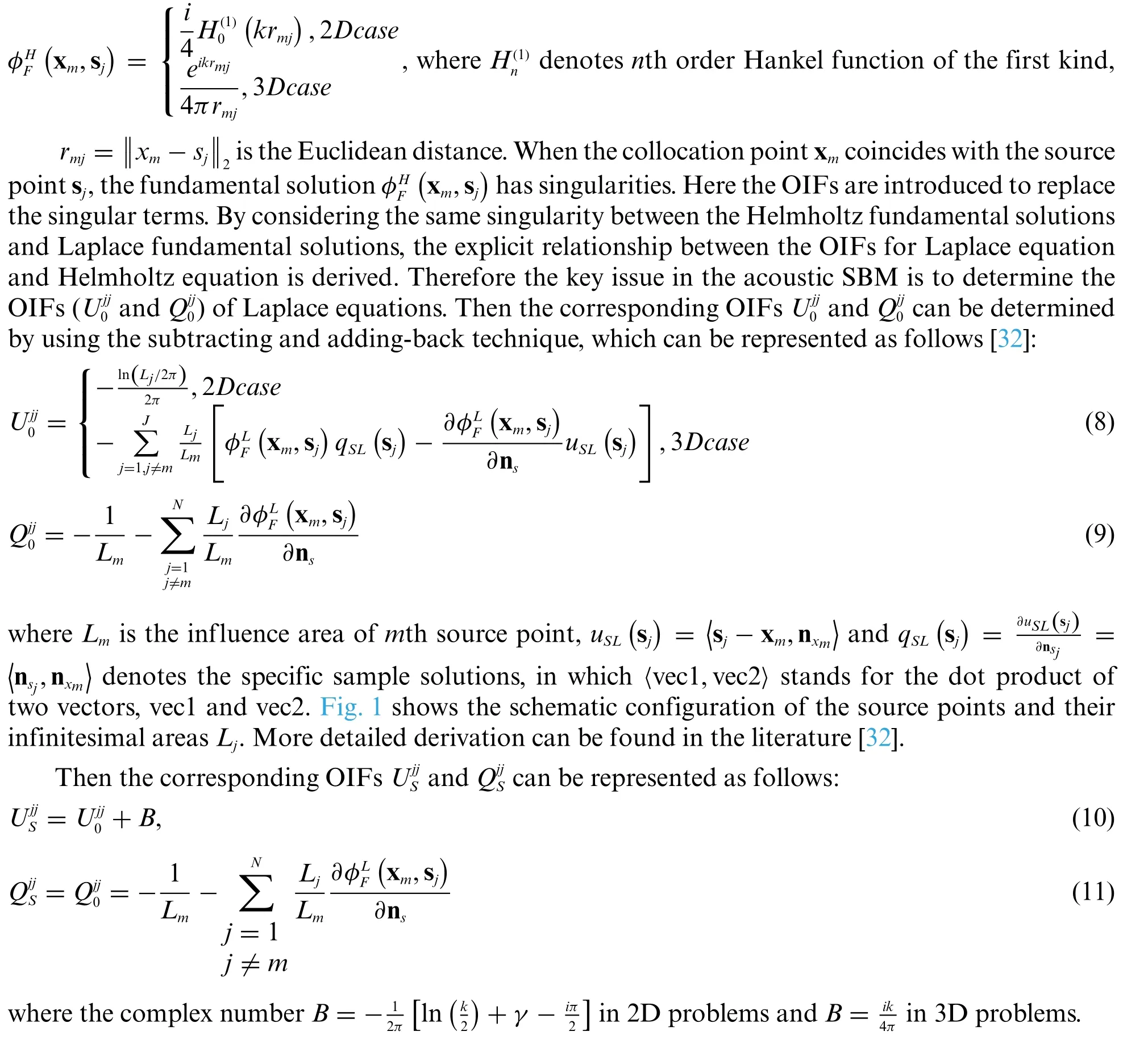
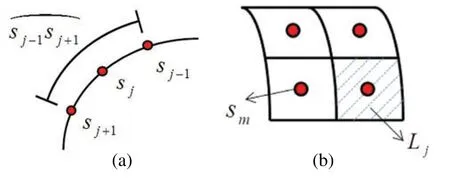
Figure 1:Schematic configuration of the source points sj (a)the curve sj-1sj+1 on 2D problems,(b)the corresponding infinitesimal area Lj on 3D problems
Taking the collocation points and the source points as the same set of boundary points, the following matrix form can be obtained by substituting Eqs.(6)and(7)into Eqs.(1)–(3),

in which
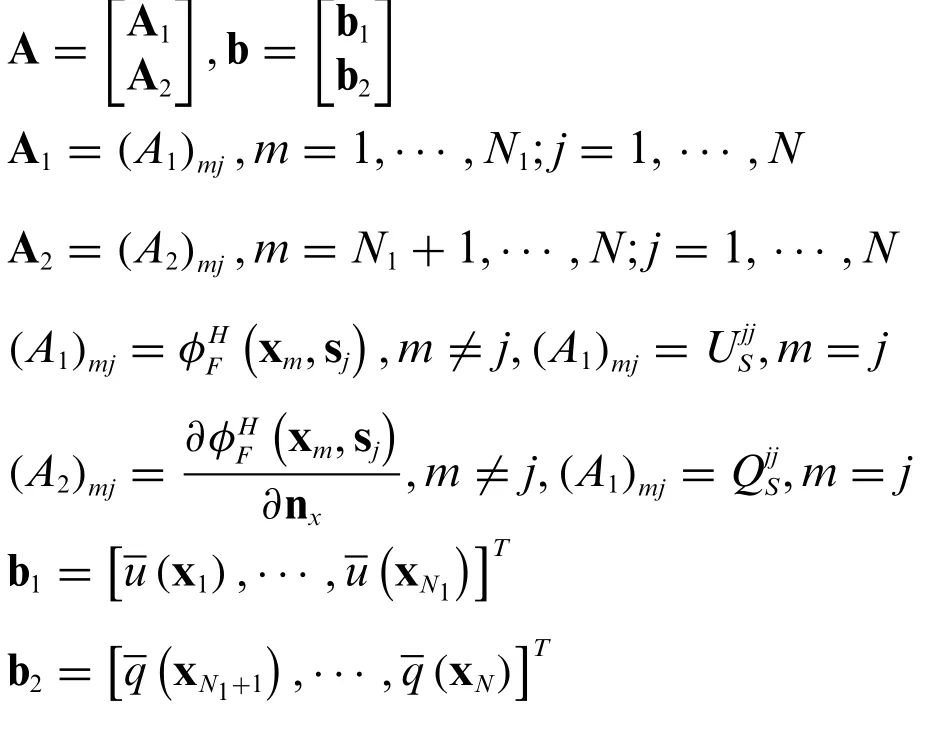
By solving Eq.(12), the unknown coefficientscan be determined.After that, the numerical acoustic pressureu(x)inside the domain and on the boundary can be calculated by using the SBM formulation(6).
2.2 The SBM Coupled with the CHIEF Method and Self-Regularization Technique(SR-CHIEF-SBM)
In the SBM solution of exterior acoustic problems,the resultant matrix is rank deficient when the wave frequency is exactly equal to the eigenfrequency of the corresponding interior acoustic problems,which makes the original SBM unable to obtain the correct solution.To overcome this non-uniqueness issue,it needs to introduceNCCHIEF points{xc}in the interior domain ℜ2Dto provideNCadditional independent constraint equations for generating a sufficient number of independent equations.
Based on the self-regularization technique and the singular value decomposition(SVD)technique,NCadditional independent constraint equations can be represented as follows:

whereφSVDcdenotes the right unitary vectors of the right unitary matrixΨSVD= [φSVDN,···,φSVD1]decomposed by using the singular value decomposition on the matrix [A]N×N= [ΨSVD]N×N[ΣSVD]N×Nin whichΣSVD=with the singular valuesσN≥σN-1≥··· ≥σ1, the superscriptHdenotes the Hermitian transpose.The SBM formulations (6) and (7) coupled with Eq.(13)are abbreviated as CHIEF-SBM in this study.The following matrix form of the CHIEF-SBM can be obtained by substituting Eqs.(6)and(7)into Eqs.(1)–(3),

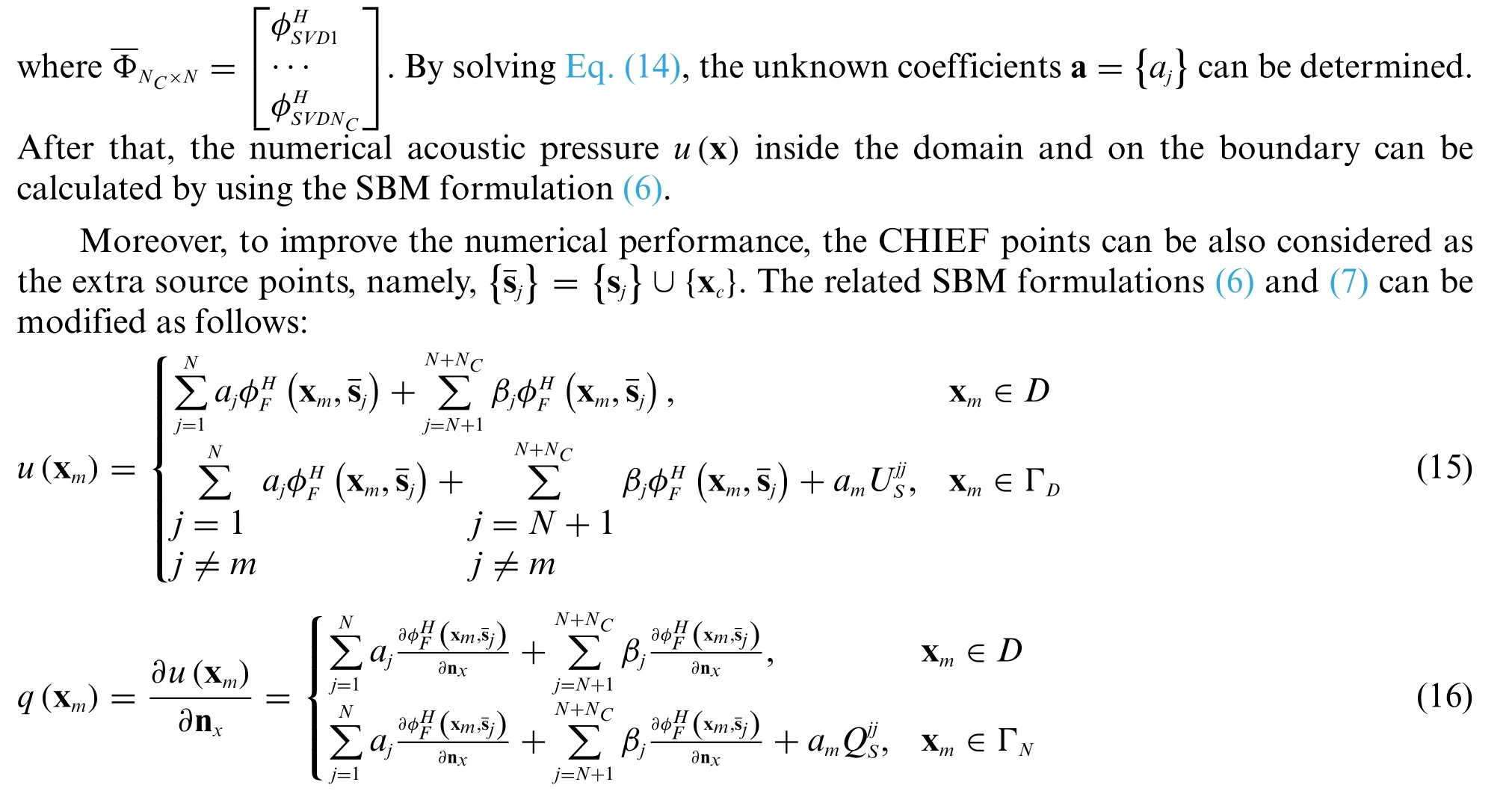
subjected toNCconstraint conditions(13).The SBM formulations(15)and(16)coupled with Eq.(13)are abbreviated as SR-CHIEF-SBM in this study.The following matrix form of the SR-CHIEF-SBM can be obtained by substituting Eqs.(15)and(16)into Eqs.(1)–(3),


By solving Eq.(17), the unknown coefficientscan be determined.After that, the numerical acoustic pressureu(x)inside the domain and on the boundary can be calculated by using the SBM formulation(15).
3 Numerical Results
In this section,several benchmark examples are presented to verify the feasibility and accuracy of the proposed SR-CHIEF-SBM in analyzing exterior acoustic radiation and scattering behavior.The present numerical solutions are compared with the analytical solutions and the ones obtained by the original SBM,the CHIEF-SBM,and the Burton-Miller SBM(BM-SBM).To measure the accuracy,the root mean square errorRMSE(u)and the maximum errorMerr(u)are defined as follows:

whereuana(xi)andunum(xi)represent the analytical solutions and numerical solutions atith test nodexi,Ntdenotes the number of total test nodes inside the domain.
Example 1:Radiation problem of a hard infinite circular cylinder(Neumann boundary condition)
Consider the acoustic radiation by a hard infinite circular cylinder.The analytical solution of the radiation fielduRis

In the proposed SR-CHIEF-SBM implementation,the parameters are set asN=300 andNC=2,the location of 2 CHIEF points in polar coordinates are(0.8a,5π/18)and(0.8a,5π/9),the test points are placed on a circle with a radius of 2a,anda=1.Fig.2 shows the convergence rates of the proposed SR-CHIEF-SBM in comparison with the original SBM,CHIEF-SBM and BM-SBM in Example 1 withka= 5.It can be found that the numerical results obtained by the proposed SR-CHIEF-SBM,CHIEF-SBM and original SBM converge to the analytical solutions with a similar rate of convergence,while the BM-SBM provides the correct numerical results with lower accuracy due to the use of the double-layer fundamental solutions.
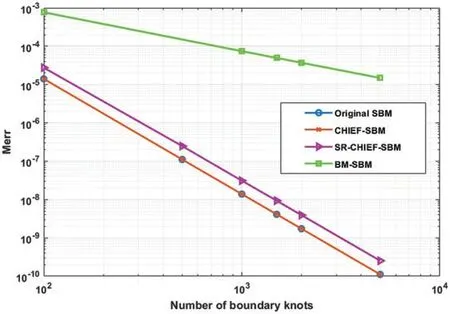
Figure 2:Convergence rates of the proposed SR-CHIEF-SBM in comparison with the original SBM,CHIEF-SBM and BM-SBM in Example 1 with ka=5
Then Tables 1–3 show the RMSE errors of the real part, imaginary part and the modulus ofunumobtained by the proposed SR-CHIEF-SBM withN= 300 andNC= 2 in comparison with the original SBM, CHIEF-SBM and BM-SBM in Example 1.It can be found from these tables that at some specific non-dimensional wavenumberska=14.372,17.616,the original SBM cannot obtain the correct numerical solutions,while both the CHIEF-SBM and SR-CHIEF-SBM provide more accurate results than the BM-SBM.

Table 1: RMSE errors of the real part of unum

Table 2: RMSE errors of the imaginary part of unum

Table 3: RMSE errors of the modulus of unum
Example 2:Acoustic radiation by a pulsating-sphere(Neumann boundary condition)
Next,consider acoustic radiation from a pulsating sphere as shown in Fig.3.The sphere is applied with uniform radial velocityv0with radiusa.This model is a typical example to verify the efficiency of the numerical methods for exterior acoustics.The analytical solution of the radiation fielduRis

wherez0=ρ0c0stands for the characteristic impedance of the medium,ρ0is the density of the medium andc0represents the sound velocity.
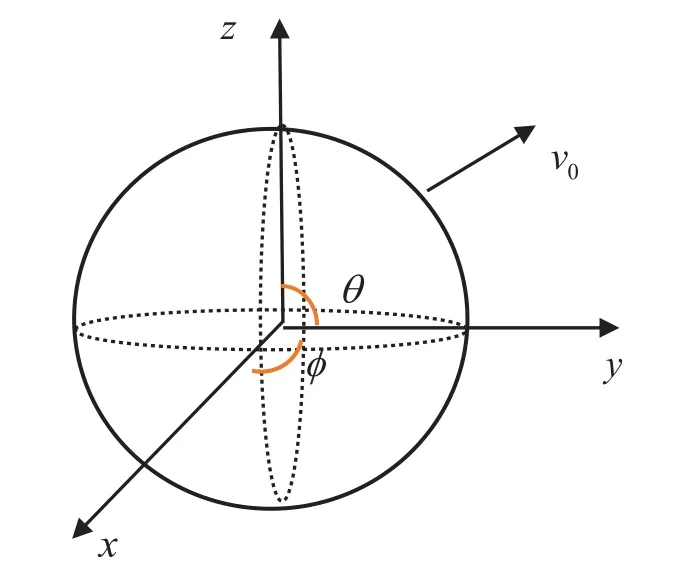
Figure 3:Sketch of the pulsating-sphere model
In the proposed SR-CHIEF-SBM implementation,the parameters are set asN=900 andNC=9,9 CHIEF points are evenly distributed on a spherical surface with radius of 0.1, the test points are placed on a spherical surface with a radius of 2.Fig.4 shows the convergence rates of the proposed SR-CHIEF-SBM in comparison with the original SBM,CHIEF-SBM and BM-SBM in Example 2 withka= 5.It can be found that the proposed SR-CHIEF-SBM provides the most accurate results among these four schemes.And both the CHIEF-SBM and original SBM provide accurate results with a similar rate of convergence, while the BM-SBM provides the correct numerical results with lower accuracy due to the use of the double-layer fundamental solutions.
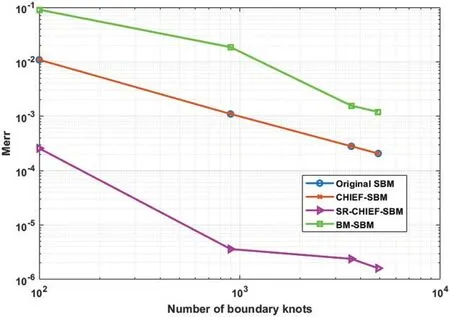
Figure 4:Convergence rates of the proposed SR-CHIEF-SBM in comparison with the original SBM,CHIEF-SBM and BM-SBM in Example 2 with ka=5
Then Tables 4–6 show the RMSE errors of the real part, imaginary part and the modulus ofunumobtained by the proposed SR-CHIEF-SBM withN= 900 andNC= 9 in comparison with the original SBM, CHIEF-SBM and BM-SBM in Example 2.The tables show that at some specific non-dimensional wavenumberska=π,2π,3π, the original SBM cannot obtain the correct numerical solutions.The CHIEF-SBM can correct the numerical results at these specific non-dimensional wavenumbers, however, it may fail in the vicinity of the aforementioned specific non-dimensional wavenumberska= 3.15,6.27,9.45.The proposed SR-CHIEF-SBM performs the accurate solutions at all these non-dimensional wavenumbers.The BM-SBM can correct the numerical solutions with lower accuracy at all these non-dimensional wavenumbers.

Table 4: RMSE errors of the real part of unum

Table 6: RMSE errors of the modulus of unum

Table 5: RMSE errors of the imaginary part of unum

Table 6 (continued)ka RMSEmod Original SBM BM-SBM CHIEF-SBM SR-CHIEF-SBM 6.27 1.51E-01 2.44E-02 1.51E-01 2.80E-05 3π 2.50E+00 2.95E-02 2.10E-03 3.97E-05 9.45 1.22E-01 2.96E-02 1.22E-01 4.25E-05
Example 3:Acoustic scattering by a hard sphere(Neumann boundary condition)
In this example, the scattering problem of a hard sphere subjected to an incident plane wave is considered.The incident plane wave is given as

where(θ0,φ0)denotes the angle of the incident plane wave in the spherical coordinates as shown in Fig.5.
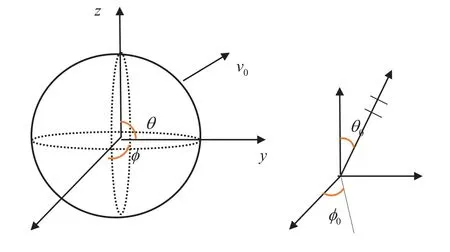
Figure 5:Sketch of the plane wave by a spherical scatter
The analytical solution of the total field is represented as

In the present numerical implementation, the parameters are set asN= 1600 andNC= 9, 9 CHIEF points are evenly distributed on a spherical surface with a radius of 0.8.Fig.6 shows the real part Re(u(2a,0,0))and imaginary part Im(u(2a,0,0))of the acoustic pressures obtained by the proposed SR-CHIEF-SBM in comparison with the original SBM, CHIEF-SBM and BM-SBM in Example 3 with the varied non-dimensional wavenumberskafrom 0.01 to 10.It can be observed that, with the increasing non-dimensional wavenumberka, the original SBM may fail to obtain the correct numerical solutions at some specific non-dimensional wavenumbers.The BM-SBM provides the correct numerical results with lower accuracy,in particular at larger non-dimensional wavenumberska.Both the numerical results obtained by the CHIEF-SBM and the SR-CHIEF-SBM are in good agreement with the analytical solutions.

Figure 6:Frequency-sweep plot:(a)Real part of acoustic pressure Re(u(2a,0,0)),(b)Imaginary part of acoustic pressure Im(u(2a,0,0))in Example 3
In the following examples, the normal velocity on the surface is produced by a point source of spherical dilatation wave with unit intensity located at the coordinate origin,then the related analytical radiation fieldsuRhave the following unified formulation:

Example 4:Acoustic radiation by a hard ellipsoid(Dirichlet boundary condition)
This example considers acoustic radiation by a hard ellipsoidshown in Fig.7.
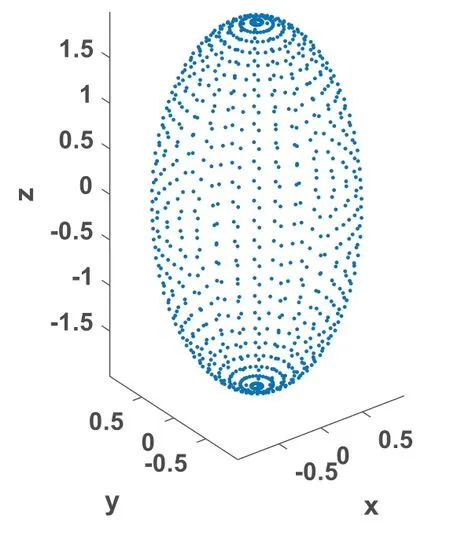
Figure 7:Sketch of wave radiation by an ellipsoid and its node distribution
In the present numerical implementation,the parameters are set asN=900 andNC=9,9 CHIEF points are evenly distributed on a spherical surface with a radius of 0.8.Fig.8 shows the real part Re(u(4a,0,0))and imaginary part Im(u(4a,0,0))of the acoustic pressures obtained by the proposed SR-CHIEF-SBM in comparison with the original SBM,CHIEF-SBM and BM-SBM in Example 4 with the varied non-dimensional wavenumberskafrom 0.01 to 10.It can be observed that,with the increasing non-dimensional wavenumberka,the original SBM may fail to obtain the correct numerical results at some specific non-dimensional wavenumbers.The CHIEF-SBM can correct the numerical results at some small specific non-dimensional wavenumbers, however, it may still fail at some large specific non-dimensional wavenumbers.Both the numerical results obtained by the SR-CHIEF-SBM and the BM-SBM are in good agreement with the analytical solutions.
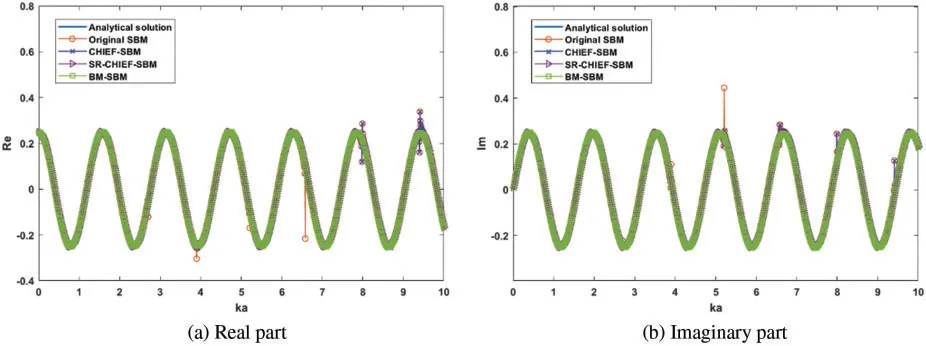
Figure 8:Frequency-sweep plot:(a)Real part of acoustic pressure Re(u(4a,0,0)),(b)Imaginary part of acoustic pressure Im(u(4a,0,0))in Example 4
Example 5:Acoustic radiation by a microphone model(Neumann boundary condition)
Consider acoustic radiation by a microphone model.Coarse and refined node distributions are shown in Fig.9.Here,the nodes are generated by COMSOL with coarse and refined meshes.

Figure 9:Sketch of wave radiation by a microphone model and its node distributions:(a)Coarse node distribution N =794,(b)Refined node distribution N =3136
In the present numerical implementation, 9 CHIEF points (NC= 9) are evenly distributed on a spherical surface with a radius of 0.05, coarse node distributionN= 794 is used in the SRCHIEF-SBM,CHIEF-SBM and original SBM.It should be mentioned that the BM-SBM with coarse node distributionN= 794 may fail to obtain the correct numerical results, therefore refined node distributionN= 3136 is used in the BM-SBM.Fig.10 shows the real part Re(u(0,0,2a))and imaginary part Im(u(0,0,2a))of the acoustic pressures obtained by the proposed SR-CHIEF-SBM(N= 794)in comparison with the original SBM(N= 794),CHIEF-SBM(N= 794)and BM-SBM(N= 3136) in Example 5 with the varied non-dimensional wavenumberskafrom 0.01 to 7.It can be observed that,with the increasing non-dimensional wavenumberka,the original SBM may fail to obtain the correct numerical results at some specific non-dimensional wavenumbers.The CHIEF-SBM can correct the numerical solutions at these small specific non-dimensional wavenumbers,however,it may still fail at these large specific non-dimensional wavenumbers and their adjacent regions.Both the numerical results obtained by the SR-CHIEF-SBM and the BM-SBM are in good agreement with the analytical solutions,while the BM-SBM requires more refined nodes to obtain acceptable results compared with the proposed SR-CHIEF-SBM.
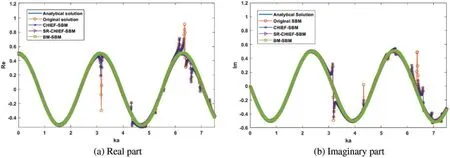
Figure 10:Frequency-sweep plot:(a)Real part of acoustic pressure Re(u(0,0,2a)),(b)Imaginary part of acoustic pressure Im(u(0,0,2a))in Example 5
4 Conclusion
This paper proposes a modified formulation of the singular boundary method (SBM) by introducing the combined Helmholtz integral equation formulation (CHIEF) and the self-regularization technique to exterior acoustics.In the proposed scheme, the use of the CHIEF scheme and the self-regularization technique not only guarantees the unique solution of exterior acoustics, but also improves the numerical accuracy in the solution of 2D and 3D acoustic radiation and scattering problems.
Numerical investigations under several 2D and 3D benchmark examples show that the original SBM fails to obtain the correct numerical solutions at some specific non-dimensional wavenumbers related to the internal characteristic frequencies due to the non-uniqueness issue frequently encountered in the boundary discretization of exterior acoustics.The CHIEF-SBM can eliminate these nonuniqueness problems at the relatively small specific non-dimensional wavenumbers,but it may still fail at large specific non-dimensional wavenumbers and their adjacent regions.The BM-SBM can provide the correct numerical solutions.However,it may require more refined node discretization and usually lose the numerical accuracy due to the use of double-layer fundamental solutions.In comparison with the aforementioned three schemes, the proposed SR-CHIEF-SBM solves the non-uniqueness issue and performs the accurate results in the present numerical experiments.
It is worth noting that with the increase of the non-dimensional wavenumber, the number and location of the CHIEF points will be sensitive to the numerical results.Some suggestions in reference[32]can be referenced to guide the way to select the CHIEF points.Extensive numerical investigations also need to be carried out to determine the optimal selection of CHIEF points.This work is under intense study and will be reported in a subsequent paper.
Funding Statement:The work described in this paper was supported by the National Science Fund of China (Grant No.12122205) and the Six Talent Peaks Project in Jiangsu Province of China (Grant No.2019-KTHY-009).
Conflicts of Interest:The authors declare that they have no conflicts of interest to report regarding the present study.
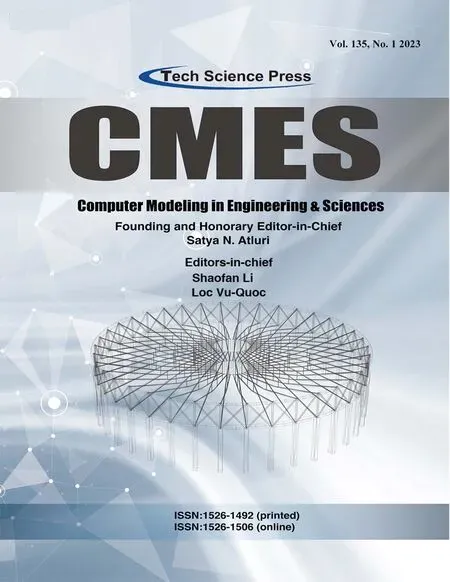 Computer Modeling In Engineering&Sciences2023年4期
Computer Modeling In Engineering&Sciences2023年4期
- Computer Modeling In Engineering&Sciences的其它文章
- A Study of BERT-Based Classification Performance of Text-Based Health Counseling Data
- Overview of Earth-Moon Transfer Trajectory Modeling and Design
- CEMA-LSTM:Enhancing Contextual Feature Correlation for Radar Extrapolation Using Fine-Grained Echo Datasets
- The Class of Atomic Exponential Basis Functions EFupn(x,ω)-Development and Application
- Corpus of Carbonate Platforms with Lexical Annotations for Named Entity Recognition
- Unique Solution of Integral Equations via Intuitionistic Extended Fuzzy b-Metric-Like Spaces
